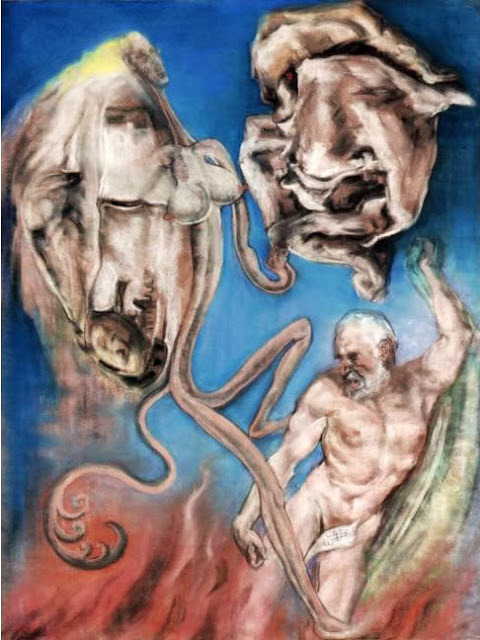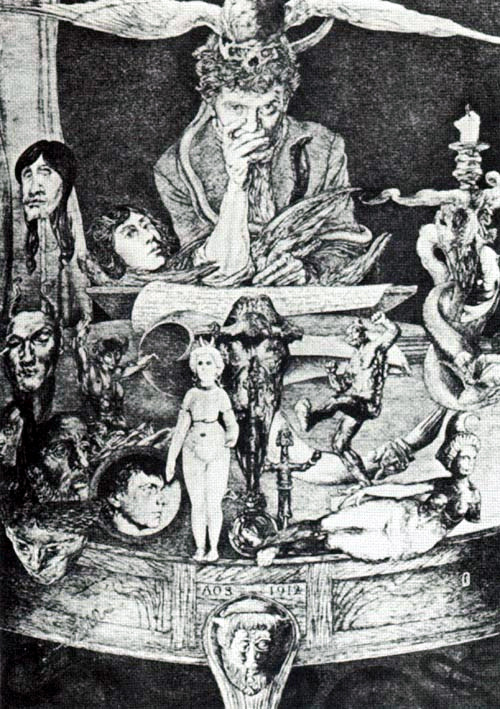By Paul McRandle
Last night in celebration of the release of the latest issue of Abraxas, Robert Ansell of Fulgur Press provided his unique, philosophical view on Austin Osman Spare’s artwork accompanied by slides and music to a packed room at Brooklyn Observatory. Opening with a realistic portrait of Spare’s friend, the artist William Smith, Ansell played a recording of Smith describing another, now lost portrait of him by Spare that when gazed at for any length of time seemed to transform into something else. This unnerving tendency of Spare’s images to shift beneath the eye shares the irritated vision Dali exploited in his paranoiac critical method. Spare’s work, however, made its occult presence felt in south London at the start of the twentieth century.

Purgatorial Purge: Insatiable Desire
For Ansell, Spare’s art responds to the philosophy and psychology of perception, and he turned to Eleonor Rosch’s theory of prototypes, which proposes that we perceive objects and experiences in the world by comparing their attributes to those of the categories we carry in our heads. As an example, if asked to imagine an apple, he suggested we would respond with our own prototypical version, perhaps with a red, green, or yellow skin, a crisp texture, specific weight and odor, etc. In language and culture, certain characteristics are more prototypical than others—crispness and redness more prototypical of the category “apple,” perhaps, than mushiness or a bitter skin. This leads to the notion of graded membership of categories, where some members like red apples are more “appley” than others like yellow apples.
Spare’s art, Ansell argues, serves to open up perception by disrupting these mental categories through ambiguity, incongruity, and multiplicity. In Spare’s terms, he creates a Neither-Neither world, which dismantles false oppositions such as “male” and “female”:
“Man implies Woman, I transcend these by the Hermaphrodite, this again implies a Eunuch; all these conditions I transcend by a ‘Neither’ principle, yet although a 'Neither’ is vague, the fact of conceiving it proves its palpability, and again implies a different 'Neither.’”
— The Book of Pleasure
This mode of thinking continued with Spare through the years, returning in more psychological terms:
The phenomenal world (not 'as it is in itself’) is the only 'real’ world we know and is entirely apparent, neither explaining nor revealing purpose, meaning etc. We imitate, compare, receive spurious impressions, and try to co-ordinate differences from which we make a synthesis and call it 'knowledge'—mere pretensions of partitive impressions and personalizations of truth with or without intentional or affective experience. This method of co-relating constitutes our Ego of flabby presuppositions—a concretion of preferential values determinative of validities and abstractions as good, bad, indifferent, etc., from a world of indifferents. But the real world, the actual 'thing in itself’, is nearer—e.g., Ego as the subjective and only reality that is not a pretentious supposition.
— Logomachy of Zos
As an exercise in this negative capacity, Ansell invited the audience to stare at the middle knuckle of a hand allowing the gaze to shift in and out of focus until the hand becomes something very different. Exploiting these stumbling blocks in perception, Spare comes very close to Max Ernst’s experience staring at the grain of floorboards: “I was surprised by the sudden intensification of my visionary powers and by the hallucinatory succession of contradictory images superimposed, one upon the other, with the persistence and rapidity peculiar to amorous memories.”
Spare’s kinship with surrealism, which included automatic drawing, struck many others as well and resulted in his being hailed in the press as England’s original surrealist, something he played with by releasing a set of Surrealist Racing Forecast Cards in 1936. Tenuous as it was, the link with surrealism eventually saved his career. Although constantly active from 1903, Spare almost disappeared from public view after a famous debut as a teenager, a situation made much worse by the destruction of his studio any many works during the wartime Blitz. The interest of Kenneth and Steffi Grant, for whom the pages of Minotaure kicked off a lifelong interest in surrealism and the occult, proved a reviving influence in his later years.

The Death Posture, 1913
From imagery Ansell moved on to percption in music, noting the Spare played clarinet and had forged connections with noted composers of his era including Kaikhosru Sorabj and Igor Stravinsky. As an example of ambiguity in sound, he played haunting, short section of an electronic piece by John Contreras composed of six tones blending and shifting in a manner impossible to peg with notes on a scale.
To discuss incongruity in music, Ansell turned to Igor Stravinsky’s Rite of Spring and a quote from George Perle: “The intersecting of inherently non-symmetrical diatonic elements with inherently non-diatonic symmetrical elements seems … the defining principle of the musical language … and the source of the unparalleled tension and conflicted energy in Le Sacre.” Spare greatly admired Stravinsky’s work, giving the composer a portrait that can now be seen in the Austin Osman Spare collection at the Harry Ransom Humanities Research Center in (of course) Austin, Texas.
Considering multiplicity, Ansell turned to Sorabji’s Opus Clavicembalisticum a piece which played in full can last for four hours. Ansell had his own encounter with Kaikhosru Sorabji some twenty years ago while working for Sotheby’s when he set out to view some works of The Eye, the house Sorabji built for himself in the village of Corfe Castle. A post at the entrance bore a large eye with the notice: Visitors Unwelcome.When he entered Sorabji’s home, his eye landed on a watercolor by Spare, starting a brief and abortive effort to find out if the composer knew the artist. Sorabji in fact possessed several signed copies of Spare prints along with the watercolor.
Sources
Austin Osman Spare: Cockney Visionary, edited by Stephen Pochin with an introduction by Robert Ansell (Jerusalem Press, 2010)
Austin Osman Spare: The Life and Legend of London’s Lost Artist, by Phil Baker (Strange Attractor Press, 2011)
The Book of Pleasure, by Austin Osman Spare (Jerusalem Press, 2011)
unuhadity reblogged this from werkboileddown
unuhadity liked this
hexternalities liked this
gotankgo liked this
werkboileddown reblogged this from surrealistnyc
collegeoftheholyspirit liked this
cesspit-dreaming liked this
 werwull liked this
werwull liked this  cirogjimemez reblogged this from surrealistnyc
cirogjimemez reblogged this from surrealistnyc  cirogjimemez liked this
cirogjimemez liked this iseesigils liked this
obscuruspaintus liked this
mayhugh liked this
ursa-inducer liked this
 vizeffect liked this
vizeffect liked this  chaosbeatnik reblogged this from surrealistnyc
chaosbeatnik reblogged this from surrealistnyc  chaosbeatnik liked this
chaosbeatnik liked this surrealistnyc posted this